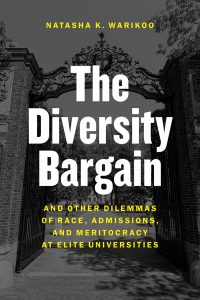The Diversity Bargain at PopMatters

Below follows an excerpt from “On Race and Meritocracy in Academia” at PopMatters, a review of Natasha K. Warikoo’s The Diversity Bargain and other Dilemmas of Race, Admissions, and Meritocracy at Elite Universities.
***
Diversity is perceived as something that’s intended to benefit everyone, including white students. It isn’t defended as being a matter of social justice, but rather as the best way to equip young Americans to succeed in today’s world. White Americans (and other students with privilege) see diversity and affirmative action as something which is intended to benefit them, and so long as it appears to be doing that, they’re okay with it. But when diversity places barriers in their way—when they experience rejection in admissions or job applications or anything else which they can find reason to blame on affirmative action—they’re quick to criticize it, or to blame it for their own shortcomings.
There’s a related imperative for minority or marginalized groups of students to appear to be living up to their ‘side’ of the ‘bargain’, i.e., giving the privileged groups exposure to their marginalized peers, and contributing to the privileged students’ education on diversity. When marginalized students form identity-based student groups, or hold events to which white students are not invited (or don’t think they’re welcome at), the privileged students become critical. They’re willing to support affirmative action in a society that considers diversity and cosmopolitanism a strength and source of social capital, but only insofar as it benefits them. “In the United States… white students supported affirmative action as long as it benefited them, namely through exposure to new perspectives. This led them to expect black and Latino students to integrate with their white peers and that affirmative action should not go ‘too far,’ such that whites begin to feel disadvantaged by it.”
This is the result of what Warikoo calls a ‘diversity frame’ of understanding affirmative action, and it was one she and her researchers found common among American students. There are other frames: the ubiquitous ‘color-blind frame’, in which students profess that everyone is equal; and the ‘culture of poverty frame’ in which they find inherent faults in the marginalized group. A few students held a ‘power analysis frame’, the one Warikoo herself seems to favor and was hoping to find, which recognizes systemic power imbalances and is more associated with a social justice imperative.
***
To read the PopMatters review in full, click here.
To read more about The Diversity Bargain, click here.